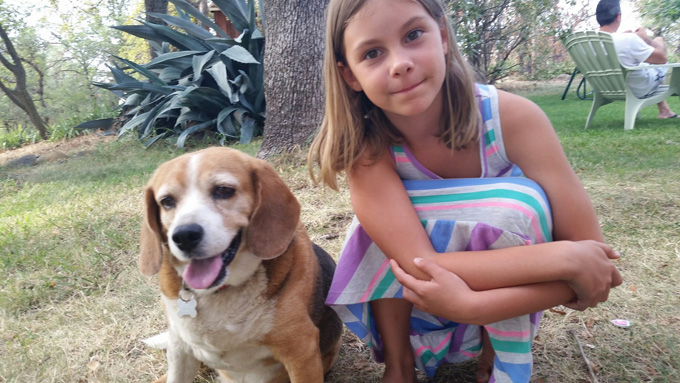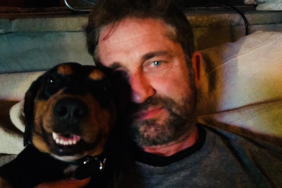A friend of mine was recently sitting at the bedside of her elderly father who was dying. Thankfully, he died of natural causes. However, I still wanted to be there for her during this difficult time.
When I went to visit her after her father passed, I noticed a Beagle, whom I had never seen before, lying in the dirt where her daughter was playing. I asked her about the new dog and my friend told me a fascinating story:
During the weeks that her father was in Hospice, her family had to deal with repeated intrusions by their neighbor’s dog–a very old Beagle, named Badges. My friend lives in the country, where dogs tend to roam freely due to the lack of fences or busy roads to contend with. In this part of Northern California, there is nothing between each home but rolling, golden fields.
As the family sat around the bedside of their dying father–a process that took weeks–they would look down and suddenly see their neighbor’s dog, sitting there with them. When they escorted the pup out the back door and locked it, he would enter through another door of the house as soon as someone opened it! Because of the intensity and chaos of the situation, the dog had lots of opportunities to enter the home, and would do so, almost single-mindedly. If a door opened, Badges would trot in as if he had been invited or had heard someone calling to him.
Finally, the family just gave up and let Badges stay. He sat quietly with them until their father passed.
Badges Stuck Around

My friend told me that, since then, Badges has stayed with them on their property most of the time. He goes home to eat and sleep, but every day, he comes over to visit the family and has especially taken to their daughter. I had to snap a photo for you.
She says that, strangely, Badges has not tried to enter the room of the deceased man since the time of his passing, even though the door to that room has remained open for anyone to enter as they pleased.
The following week she told Badge’s owner how he had been spending so much time with them and how the dog had sat at the side of the bed as her father passed. They weren’t surprised. His owner told her that Badges “has always been an emotional dog.” They described him as “in tune” with the people around him.
As my friend told me this story, I wondered how these people could know that their dog is an “emotional dog”? Looking at his rumpled, old face, I’d never guess. It seemed almost ridiculous that this dog could sense that someone was dying from across acres and acres of land, but the facts bear out the owner’s claim.
Do Dogs Understand Death?
Whether or not dogs are sensitive to grief and death used to be a question, but now, both scientific and anecdotal evidence seem to have united behind constantly mounting studies and real-life stories.
So many of us have heard about the famous brown Labrador, Hawkeye, who loyally sat at the side of his Navy Seal owner’s casket as the funeral proceeded. Many of us have our own experiences with animals being in tune to the emotions of the people around them–tales that are told over and over again within families, friend to friend and on the Internet.
A fascinating article published by Steven Kotler in Psychology Today tells the story of a mixed breed Chihuahua who repeatedly covered his brother’s head with a blanket after he was hit by a drunk driver’s car.
Though this might be exceptionally emotional behavior among dogs, there are millions of similar stories.
While researching, I found a post on Yahoo where the owner of a Wirehaired Pointer named Angus, lost his mother, Bimmer to pancreatitis. Angus lied down at her side as she passed and licked her front paws. This owner was convinced: “They feel it..They sense it..They know.”
As it happens, the depression that accompanies the death of a loved one is not much different for a dog. They sleep more than normal, move slower, eat less and don’t play as much. It may take anywhere from a few weeks to a few months, pet experts believe, before a dog’s spirits begin to lift after the passing of someone they love.
Can You Help A Mourning Dog?
It might be helpful to adopt a strategy in handling the mourning process of your pet if this happens to you.
Some great advice from Dr. Christopher Pachel, a Board Certified Veterinary Behaviorist:
The natural instinct might be to want to console, comfort, soothe and nurture the grieving dog, but that may feed into negative emotional processes. Most experts agree that maintaining a normal routine for the animal is helpful.
Some dogs mourn, and other dogs don’t. It is best to move slowly. Keep an article of clothing, or an old blanket that belonged to the deceased, so the dog can transition through the loss. Keep the dog active. If they can play, let them. Just like anyone else, they need a reason to move on and enjoy life again.
Many owners make the mistake of introducing a new dog to the family too quickly, in an effort to fix the problem. Whether or not to adopt or rescue another dog depends on the breed and personality of the dog in crisis. Many times the addition of a new dog, during a time of weakness in the family life of a grieving animal, can be highly counterproductive. Sometimes it’s difficult to know what to do. It might be helpful to realize that it’s not that different for dogs than for humans.
We All Grieve
Dogs grieve. People grieve. We search for the right words to say to someone who has lost a loved one. It can be uncomfortable. From experience, I can say that understanding death gets easier when you’ve done it before. What can one say to a dog in mourning? Don’t they operate on an entirely different plane of existence? Yes, but, thankfully, our experiences collide. We learn from them, they learn from us. We lean on them, they lean on us.
The beauty of a relationship with a dog is in making that effort to understand one another. I guess it isn’t that different from our relationships with our mothers, brothers, husbands and children.
That’s what life is all about, right? Understanding is our goal. Love is our comfort and it’s worth it.









